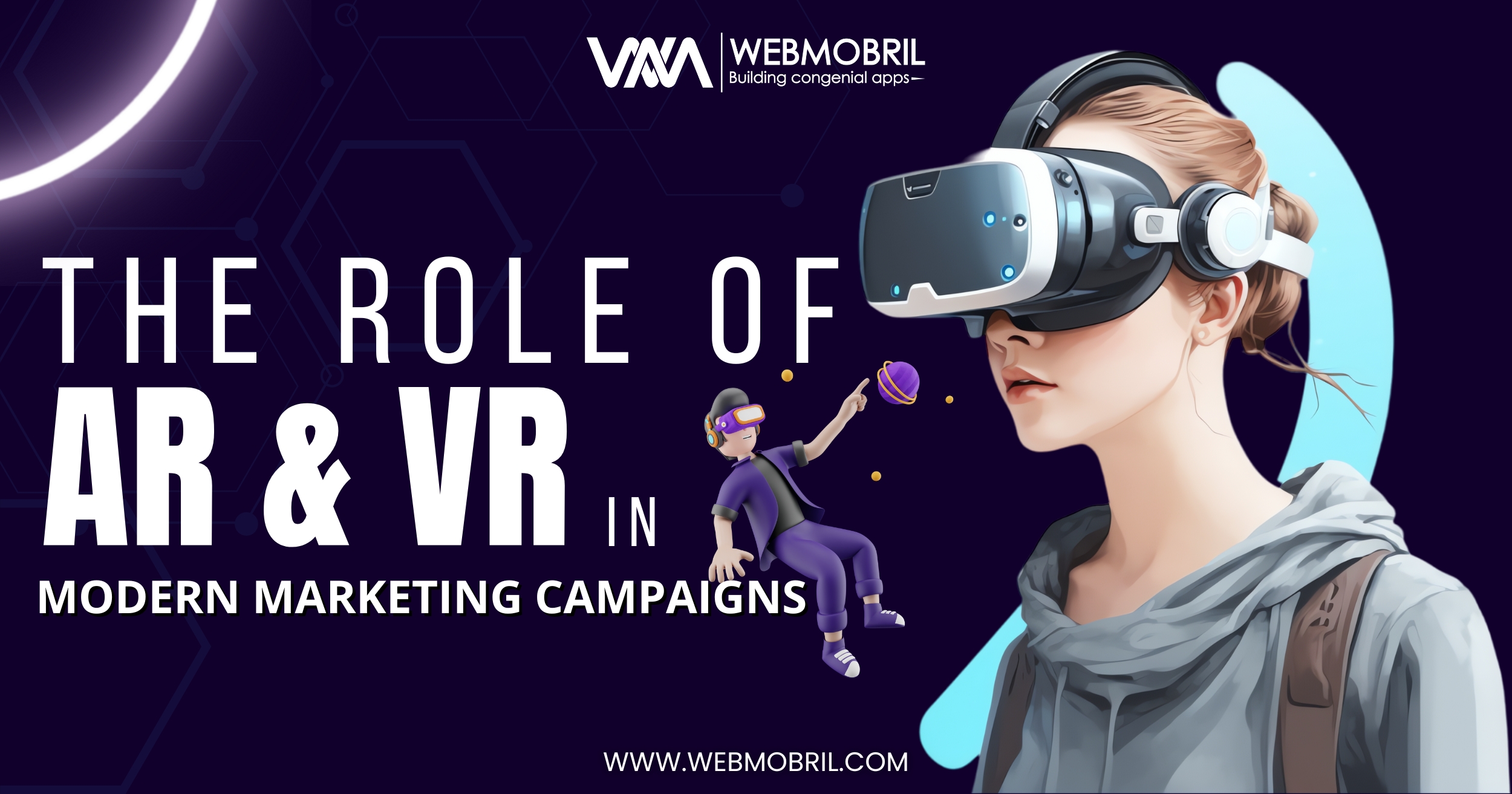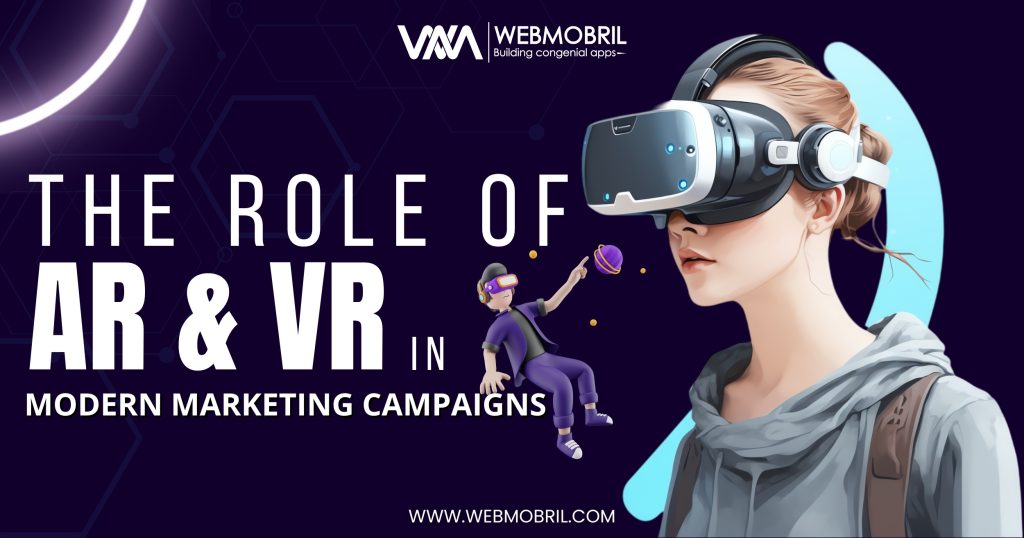Modern marketing strategies now feature immersive experiences because our world has become digitally advanced. The modern marketing landscape has experienced a fundamental change because of Augmented Reality (AR) and Virtual Reality (VR) technologies which allow brands to interact with their target audiences in unprecedented ways. Modern consumer engagement has undergone a permanent transformation because these technologies serve as fundamental changes in brand communication methods as well as consumer interactions while enabling brand-customer relationships.
Businesses need to adjust their strategies immediately for holding onto their customer base because people seek personalized experiences during their interactions with brands. The strategic implementation of AR/VR technologies by marketers produces three essential outcomes: audience attention capture along with emotional involvement and permanent brand memories. Authors study how the future of marketing development relies on AR/VR through an examination of custom AR/VR games for market transformation.
The Rise of Immersive Technology in Marketing
Both AR and VR technologies have experienced exponential growth during the last ten years. Businesses now benefit from affordable headsets combined with improved smartphones and rapid internet connectivity which decreases market entry obstacles. Modern digital platforms receive enhanced high-fidelity interactive content through marketing capabilities enabled by this development.
The technologies extend their application beyond entertainment boundaries. Through their integration in marketing activities these technologies enable on-the-spot contact with digital elements found in real-world settings (AR) or complete digital simulated worlds (VR). This level of engagement produces longer customer interactions that boost brand relationships which drives greater sales success rates. The brands which adopt immersive technologies can boost their brand loyalty because they deliver interactive content and storytelling experiences.
Enhanced Brand Storytelling Through AR/VR
The most powerful use of AR/VR technology in marketing operates through improved brand storytelling systems. The consumption of traditional advertisements remains passive since viewers can only watch static or linear content. AR/VR systems actively involve users as part of narratives since they can move through stories and shape the conclusion through their choices.
The fashion industry utilizes virtual reality to give users virtual runway experiences while automobile manufacturers let their customers experience virtual test drives in 360-degree views. These scenarios place people directly into stories beyond mere storytelling. Custom AR/VR game development builds on this concept yet further through game-based brand storytelling approaches that let users both compete and achieve accomplishments that echo the brand narrative.
Data-Driven Personalization at Scale
The interaction data collected through AR/VR technology creates an extensive data resource for marketers to build improved strategies that offer highly personalized brand interactions. The analysis of eye-tracking during VR sessions helps identify what captures attention whereas AR experience duration indicates which aspects users favor. The metrics help marketers speed up their process of campaign optimization through precise adjustments.
Brands that develop AR/VR games according to their specifications gain instant access to real-time behavioral data from users. Game development teams use specific gameplay mechanics that address distinct market segments, product types or brand identity matters. Marketers obtain valuable increase in personalization and message effectiveness by studying how players behave which results in actionable market insights.

Gamification and Engagement Strategies
Gamification serves as an effective user engagement tool and AR/VR technologies push its boundaries further. Market developers use their ability to create customized AR/VR games to design brand experiences which promote exploration alongside competitive and rewarding dimensions. When used in customer campaigns these strategies help people both remember brand messages better and develop strong emotional engagement with the brand.
The beverage company uses an AR-based scavenger hunt which provides users with special discounts and exclusive merchandise. VR technology allows users to complete brand-related challenges and puzzles which educate them while providing entertainment value. The implemented strategies create financial motivation for users to participate while enabling word-of-mouth promotion which extends the advertisement’s natural spread.
Revolutionizing Product Visualization
Product visualization remains a considerable problem in digital marketing practice. Users can explore product virtual replicas through AR/VR technologies which helps them make better purchase decisions. The capability of AR enables customers to visualize digital products while existing in their natural environments and VR generates complete virtual showcases.
Retail companies currently embrace this capability through market adoption. Using AR technology furniture brands enable customers to virtually see what their selected couch would appear in their home living room. Through their AR solutions cosmetic brands allow customers to virtually test different products matching their appearance Retailers use these applications to decrease product returns and generate better satisfaction results while increasing consumer purchase self-confidence.
Integrating AR/VR with Omnichannel Campaigns
Modern marketing strategies hinge on seamless omnichannel integration. AR/VR content achieves seamless brand experience because it integrates smoothly between social media as well as websites and mobile applications while still supporting physical store interactions. The engagement started through VR within stores continues uninterrupted through mobile AR applications which provide users with a continuous cohesive experience.
Companies using custom AR/VR games can use them to reinforce their omnichannel marketing initiatives. Brands unite their platforms through achievement reward connections that enable users to collect loyalty points and access exclusive social media content so users stay motivated through a cohesive system. The uniform usage across different platforms helps maintain brand recognition while prolonging user dedication toward the brands.
Training, Education, and Internal Marketing
The internal marketing program of AR/VR technology delivers substantial value through employee training sessions and first-contact employee onboarding programs. Through VR simulations companies train their sales personnel to handle actual client interactions by using controlled virtual customer encounters. Technicians together with customer service agents receive virtual real-time directions through AR guides for assistance.
The internal applications of AR/VR help employees to transform into brand representatives who possess complete marketing capabilities. Custom-made immersive games developed for AR/VR systems help organizations achieve better learning engagement while producing collaborative teams and performance evaluation which enhances employee motivation and capacity.
The Evaluation of AR/VR Marketing Success Along with Return on Investment Assessment
Companies need to use specialized metrics to measure the achievement of AR/VR marketing initiatives which extend past standard KPIs. Several metrics which include session duration along with user immersion levels and interaction frequency and biometric feedback allow marketers to apprehend complete campaign performance. The collected data enables strategic team improvements to marketing approaches while supporting ROI justification.
Advanced analytics tools included in customized AR/VR game development platforms allow live tracking followed by instant reports. Marketing teams gain insights about player conduct alongside conversion flow measurements and engagement map illustrations to discover profitable changes. The implementation of real-world data measurements within AR/VR campaigns serves as their key innovation factor and strategic value driver.
The Future: Scalable, Adaptive, and AI-Driven Experiences
Virtual reality and augmented reality solutions will achieve new heights as their merger with Artificial Intelligence and 5G technology expands their operational potential. User behavior-driven personalized content will adopt through AI to adapt dynamically. The arrival of 5G technology will make high-quality real-time rendering of AR/VR content possible through streaming.
Custom AR/VR game development will experience advancements through the integration of adaptive narratives and intelligent non-player characters and dynamic simulations into their programming. Deeply personalized scalable digital experiences will become possible through these advancements because they enable instant responses to customer user interactions. Marketing innovators will shape the upcoming experience in branding through their investment in technology development.
Conclusion: Partner with WebMobril for AR/VR Marketing Solutions
The current digital marketplace requires both VR and AR as essential tools which allow brands to build immersive high-impact campaigns. The implementation of AR/VR technology enables marketers to create meaningful changes in how they conduct marketing activities thereby transforming the industry.
WebMobril delivers individual AR/VR game development services to make your marketing concepts become reality. The solutions we offer at WebMobril specifically adapt to match your company’s individual business objectives whether you want to achieve audience capture through interactive stories or boost engagement with gamified content or create complete immersive product views. We use our mastery of technical expertise and creative strategic approach to develop scalable intuitive solutions that drive business results for AR/VR experiences.

